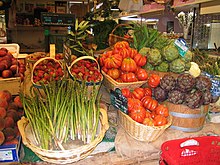Provençal markets
- View a machine-translated version of the French article.
- Machine translation, like DeepL or Google Translate, is a useful starting point for translations, but translators must revise errors as necessary and confirm that the translation is accurate, rather than simply copy-pasting machine-translated text into the English Wikipedia.
- Consider adding a topic to this template: there are already 1,406 articles in the main category, and specifying
|topic=will aid in categorization. - Do not translate text that appears unreliable or low-quality. If possible, verify the text with references provided in the foreign-language article.
- You must provide copyright attribution in the edit summary accompanying your translation by providing an interlanguage link to the source of your translation. A model attribution edit summary is
Content in this edit is translated from the existing French Wikipedia article at [[:fr:Marché de Provence]]; see its history for attribution. - You may also add the template
{{Translated|fr|Marché de Provence}}to the talk page. - For more guidance, see Wikipedia:Translation.

Provençal markets or markets of Provence have become one of the regional emblems of Provence-Alpes-Côte d'Azur. Traditional markets held in a town or village are events that are both a celebration of local identity, and a collective ceremony in which everyone is both the participant and spectator, as well as a meeting place where everyone is equal and no one is excluded.
Tourism and tradition
Very often, the traditional markets – some date from the Middle Ages – occupied squares and little streets and their main goal was to channel the provision of food supplies in towns and villages and to keep informed as well.
With the rise of mass tourism during the 20th century the festival of colours and smells provided by the local fruits and vegetables, as well as spices and Herbes de Provence, itself became an attraction.
Summer season
In the summer, the traditional holiday period, one will find tomatoes, peppers, lettuces, black and green olives, onions, apricots, peaches, figs, grapes, etc., not to forget local produce such as the Cavaillon melon, candied fruits from Apt, calissons from Aix, nougat from Sault, strawberries from Carpentras or fish from the coasts.
The Provençal market also offers local specialities such as essential oils of lavender from Haute-Provence, cut and dried flowers, and all kinds of soap products. Finally, it is also the chance to discover truffles, lavender honey, cordials, jams, olives, designation of origin oils and fine wines from the Rhone Valley and Provence.
Bibliography
- Dixon and Ruthanne Long, Markets of Provence: A Culinary Tour of Southern France (1996)
- Marjorie R. Williams, Markets of Provence: Food, Antiques, Crafts, and More (2016)











